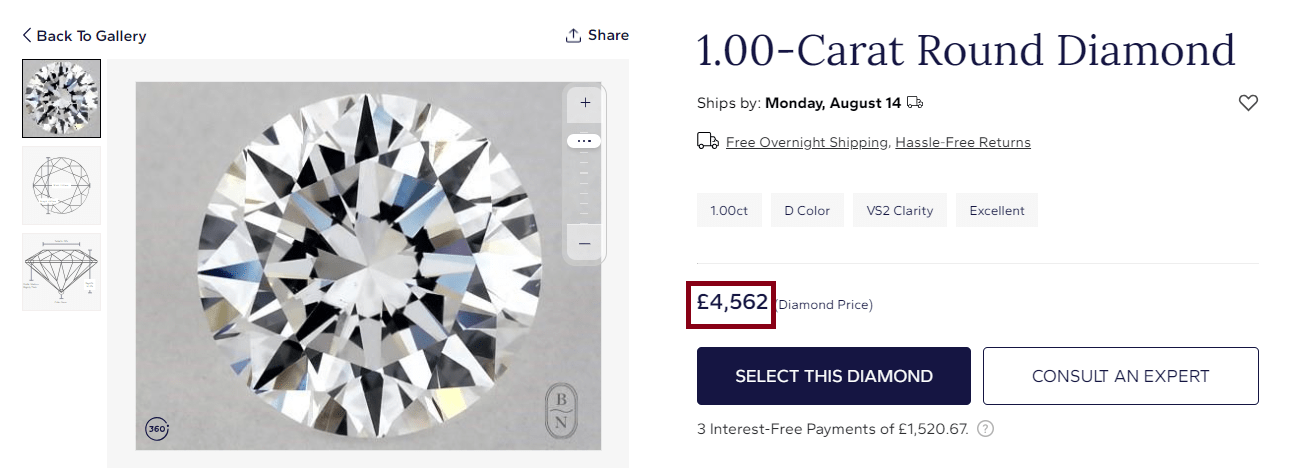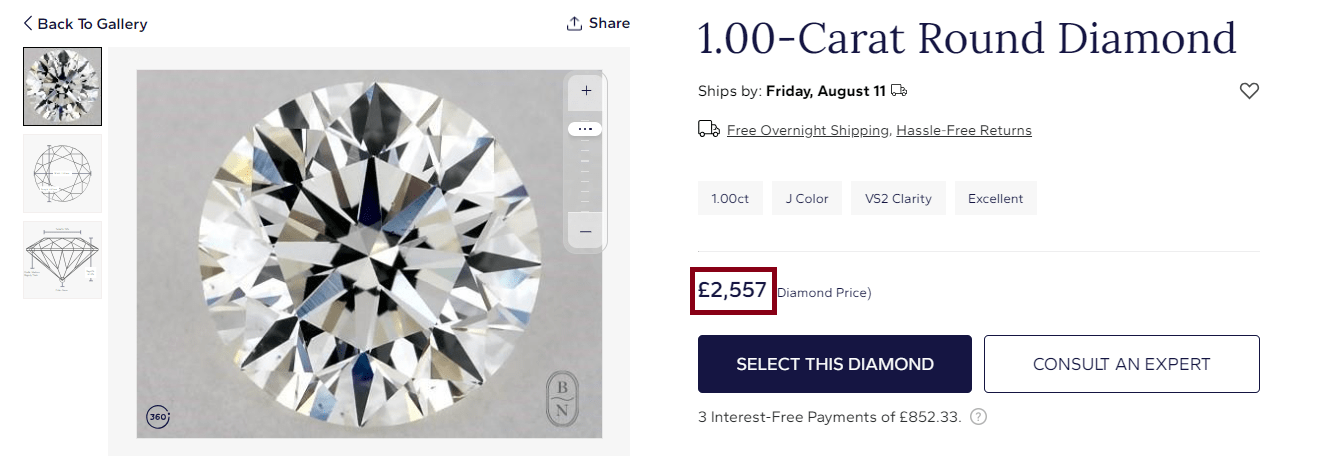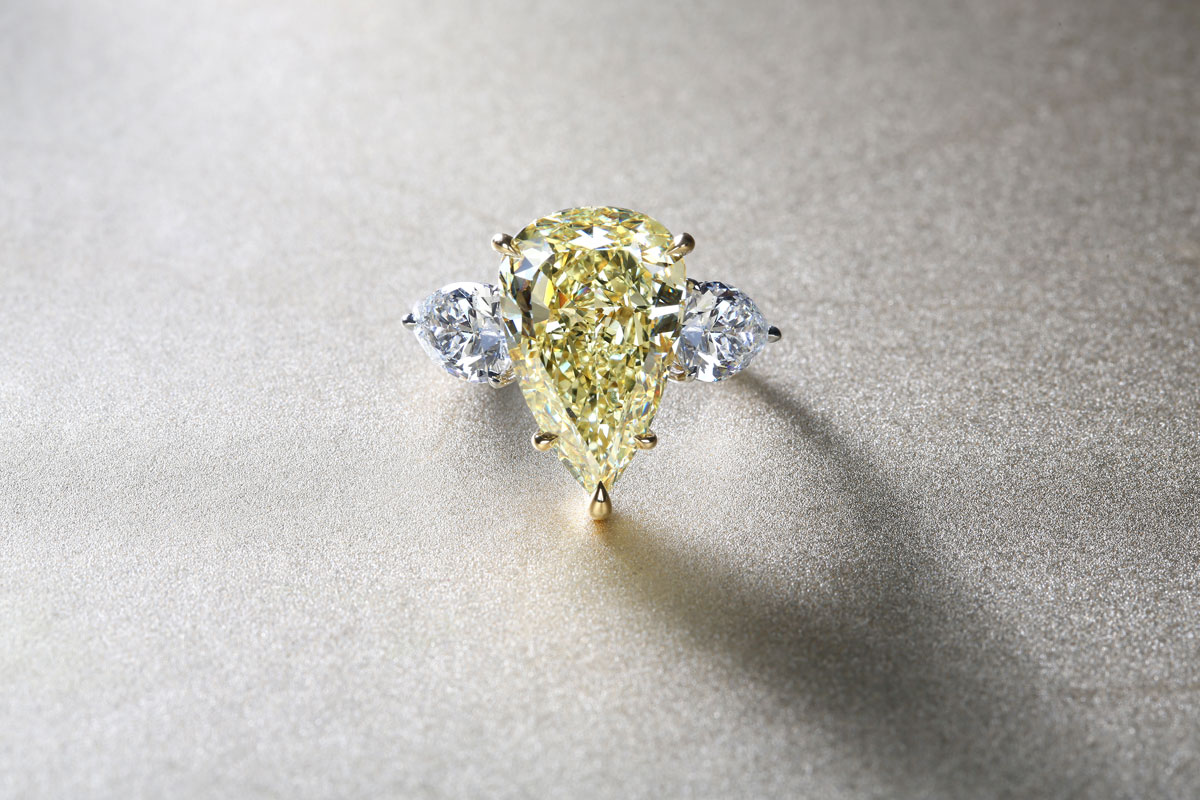Diamond colour isn’t just about aesthetics; it’s a critical factor that affects a diamond’s value. If you’re planning to buy a diamond and are confused about which colour grade to select, this guide is here to help.
In this comprehensive guide, we’ll explain the essentials of diamond colour. We’ll cover the widely-accepted GIA diamond colour scale and delve into the fascinating world of fancy colour diamonds. Curious about how different shapes influence colour perception? Or how to choose the right shade that aligns with your budget? We’ll provide clear answers.
We’ll also touch on the future trends in diamond colour technology, giving you insight into what’s next in the industry. So, without further ado, let’s dive into the practical world of diamonds.
Introduction to Diamond Colour
Diamond colour is a crucial factor to consider when buying a diamond, as it directly affects both the appearance and value of the stone. It refers to the natural tint present in a white diamond and measures how white or yellow a diamond is.
- Colourless diamonds are the rarest and most valuable, making them more expensive.
- Diamonds with brown or yellow tints are often considered lower quality and less desirable.
As you can see, the closer a diamond is to being colourless, the more valuable it becomes.
To accurately determine a diamond’s colour, professionals use the diamond colour grading system. This standardised measurement assesses the amount of colour in a diamond, ranging from perfectly colourless (D) to a light yellow/brown tint (Z). It’s
important to note that other diamond colours, such as pink, blue, or green, aren’t graded on this scale and have unique grading criteria and terminology.
What Causes Diamond Colour?
Diamond colour is primarily caused by the presence of impurities and structural defects within the crystal lattice of the diamond. Here’s a detailed look at what causes diamond colour:
- Impurities: The presence of trace elements within the diamond’s structure can impart colour. For example:
- Nitrogen: The most common impurity in diamonds, nitrogen atoms can replace carbon atoms in the crystal structure, causing a yellow or brown tint.
- Boron: This element can cause a blue hue in diamonds.
- Structural Defects: Sometimes, the way the carbon atoms are arranged in the diamond can affect its colour. For example, plastic deformation during the diamond’s formation can lead to graining that absorbs light differently, leading to a brownish hue.
- Radiation Exposure: Natural radiation in the earth can alter the diamond’s structure, leading to green colouration in some stones.
- Natural Colouration in Fancy Colour Diamonds: In fancy colour diamonds, the colour is often more intense and can be due to complex interactions of impurities, defects, and other factors. For example, the presence of hydrogen can cause grey or blue colours, while vacancies in the crystal lattice can cause pink or red hues.
- Artificial Treatments: It’s also worth noting that some diamonds are treated to enhance or change their colour. These treatments can include High-Temperature Annealing (HTA) to improve or modify colour, or coating to add specific hues.
Now that we understand what diamond colour is and what causes diamond colour, let’s explore the diamond colour grade.
Understanding the Diamond Colour Scale
Let’s explore the renowned GIA diamond colour scale and delve into the fascinating world of fancy colour diamonds.
The GIA Diamond Colour Scale
The Gemological Institute of America (GIA) diamond colour scale is the industry standard for grading the colour of diamonds, and it’s widely used by jewellers and gemologists to accurately grade diamonds.
It ranges from D, representing a completely colourless diamond, to Z, which indicates a diamond with noticeable colour. Higher colour grades (D-F) on the GIA scale indicate a lack of colour, while lower grades (G-Z) may have noticeable colour. The higher the colour grade, the more valuable the diamond.

- Colourless diamonds graded D on the GIA scale are highly prized for their lack of colour. They allow more light to pass through, enhancing their brilliance.
- Diamonds that are graded E-F are considered perfectly colourless and are extremely rare.
- Diamonds that are graded G-J are considered near colourless – these have very little colour that’s imperceptible to the naked eye. They provide great value for money because only gemologists can distinguish between colourless and near-colourless diamonds.
- Diamonds that are graded K-M are faint colour diamonds. The colour can be detected when the diamond is in a face-up position.
- Diamonds that are graded N-R have a faint yellow tint that’s visible to the naked eye.
- Diamonds that are graded S-Z are light and contain a noticeable yellow or brown tint.

Fancy Colour Diamonds
Not all diamonds fit into the traditional D to Z colour grading scale. Diamonds with intense hues, like blue, green, or pink, are classified as fancy colour diamonds. These diamonds are graded based on the intensity and purity of their colour, and their value can be significantly influenced by the rarity and appeal of the specific hue.
Natural colour in fancy colour diamonds is a result of specific trace elements or distortions in the crystal structure. It’s what gives these diamonds their unique and stunning appearance. For instance, yellow diamonds are a popular type of fancy colour diamond. Their vibrant hue can range from pale to vivid yellow.
How Diamond Colour Can Impact the Price of a Diamond
The colour of a diamond has a significant impact on its overall price. The closer the diamond grade is to ‘colourless’, the more expensive the diamond will be.
Let’s take two round 1-carat diamonds that have the same clarity (VS2) and cut (Excellent), but different colour.
The first diamond is D-coloured, and is priced at £4,562:

While the second diamond is J-coloured and priced at £2,557:

As you can see, the D-coloured diamond is significantly pricier and it costs £2,000 more than the J-coloured diamond.
Both diamonds are the same clarity and cut grade, and once mounted in a ring will look very similar.
Selecting the Right Diamond Colour for Your Budget
Here are some of our tips on choosing the right diamond colour that fits your budget.
- Consider ‘Near-Colourless’ Grades: Diamonds in the G-J range are classified as near-colourless and can offer excellent value for money. The slight colour in these diamonds is often not perceptible to the untrained eye, especially when set in a ring.
- Match Diamond Colour to the Setting: The colour of the metal used in your setting can either mask or enhance the colour of your diamond. For instance, yellow gold can complement lower colour grades (K-M), making them appear whiter, while white gold or platinum settings pair well with higher colour grades (D-J).
- Balance Colour With Other 4Cs: Sometimes, it’s worth compromising slightly on colour to invest more in cut quality, which has a significant impact on a diamond’s brilliance and sparkle. A well-cut diamond can often appear more vibrant, masking slight colour tints.
- Consider Diamond Shape: Some diamond shapes, like the round brilliant, are better at hiding colour than others. If you’re considering a lower colour grade, choosing a shape that masks colour well can help you maximise your budget.
- Seek Professional Guidance: Consulting with a gemologist or a trusted jeweller can provide valuable insights into how to balance colour with other diamond qualities within your budget. They can help you understand where you can make compromises without significantly impacting the diamond’s overall beauty.
The Influence of Diamond Shape and Setting on Colour
The colour of a diamond is not only determined by its inherent hue but it’s also significantly influenced by its shape and setting. So, let’s delve into how different diamond shapes affect the perception of colour and offer tips on choosing the right setting to either complement or hide the diamond’s colour.
How Diamond Shape Influences Colour Perception
The shape of the diamond plays a crucial role in how the colour is perceived. Different diamond shapes reflect light in unique ways, affecting how the colour is seen.
For instance, round diamonds, known for their superior light performance, are particularly adept at masking slight colour tints, making them a popular choice for lower colour grades. Conversely, elongated shapes like pear, oval, or marquise tend to display more colour, especially at the points or tips. Emerald and Asscher cuts, with their large, open tables, can also reveal more colour, making higher grades more desirable.
In certain shapes, a J colour diamond may appear more tinted. Similarly, a K colour diamond may look different in various shapes.
A G colour diamond is considered near-colourless, and its appearance can vary depending on the shape. Some fancier shapes like emerald may make it look more coloured.
Some diamond shapes with a larger table, like an emerald cut diamond, may show more colour. This can be either an advantage or a disadvantage, depending on your preference.
Enhancing or Hiding Colour Through Setting
The setting of a diamond can either enhance its natural colour or help hide any unwanted hues. Here’s how to make the right choice:
- When buying a diamond, consider how the setting will interact with the diamond’s colour. The right setting can make a significant difference in the overall appearance.
- In a diamond ring, the metal and design of the setting can either complement or contrast with the diamond’s colour, affecting how it’s perceived.
- For a warmer colour like K, choosing a yellow gold setting may enhance the warm hue, while a white gold setting might diminish it.
- Some settings can hide colour better, such as bezel settings that cover the diamond’s edges, reducing the visibility of any tint.
- Placing a diamond in a yellow gold setting can enhance or hide certain colours, depending on the diamond’s grade and the design of the setting.
Practical Tips for Purchasing the Perfect Diamond Colour
Selecting the perfect diamond colour is a nuanced process that requires careful consideration of various factors. This section provides practical insights into balancing colour with other diamond characteristics and expert guidance on choosing the right colour.
Balancing Colour and Clarity
Colour and diamond clarity are two essential aspects of a diamond’s quality. Understanding how they interact can help you find the perfect balance for your needs, so here are some of our best tips.
- The colour grade scale helps you understand the range of colours available, from completely colourless to faintly tinted. Knowing where a diamond falls on this scale can guide your decision.
- The best colour grade for you may not necessarily be the highest. Consider the overall appearance of the diamond and how the 4Cs interact with each other. Sometimes, opting for a slightly lower grade can save money without sacrificing appearance.
- Colour and clarity are interrelated. A diamond with high clarity but a lower colour grade may appear more brilliant, while a higher colour grade with lower clarity might lack sparkle.
- An E colour diamond is considered colourless and can be paired with various clarity grades to achieve the desired effect.
- A near-colourless diamond offers flexibility in balancing colour and clarity, often providing excellent value for money.
Expert Guidance on Selecting Diamond Colour
In order to choose the right colour, you need to consider your preferences, budget, and the overall design of the jewellery piece.
- Some diamonds may have a trace of colour that adds unique character. Understanding this can help you select a diamond that resonates with your style.
- Take into account how the colour grade interacts with the other 4Cs. For instance, purchasing a diamond that has a very high colour grade but a very low clarity grade isn’t a good idea because the diamond will look unbalanced.
- H colour diamonds are popular for their near-colourless appearance and affordability, making them a great choice for many buyers.
- An F colour diamond is considered near-colourless and offers a beautiful balance between quality and price.
- When purchasing a diamond, consider seeking expert guidance to help you navigate the complexities of colour selection.
Whether you’re drawn to the brilliance of a colourless diamond or the unique charm of a faintly coloured diamond, your choice should resonate with your taste and lifestyle. Choosing the right colour requires careful consideration of your preferences, the setting, and how the diamond will be worn.
Conclusion: Finding the Right Diamond Colour for You
Understanding the colour of a diamond is not just about aesthetics; it’s a crucial aspect that significantly affects the value and appeal of the gemstone. As we’ve explored, knowing about the diamond colour scale, from the colourless grades to the fancy colour diamonds, provides insights into how valuable a diamond colour can be.
Moreover, since the colour of the diamond is one of the four Cs that contribute to its overall grading, it’s essential to recognise how it aligns with the other diamond qualities, like clarity, cut, and carat weight. Whether you prefer a G colour grade or a more unique hue, understanding the nuances of diamond colour can guide you in making an informed and satisfying purchase.
FAQs
Fancy colour diamonds exhibit intense hues beyond the normal colour range graded by the the regular GIA colour scale e.g. pink, blue or green. Unlike white diamonds, they are graded based on the intensity and purity of their colour rather than the absence of colour.
The colour of a diamond is one of the critical factors that determine its quality and value. While some people prefer colourless diamonds for their brilliance, others might appreciate diamonds with unique hues.
The colour grade directly impacts the diamond’s price. Higher colour grades, indicating less colour, are typically more valuable, while lower grades with noticeable hues may be more affordable.
